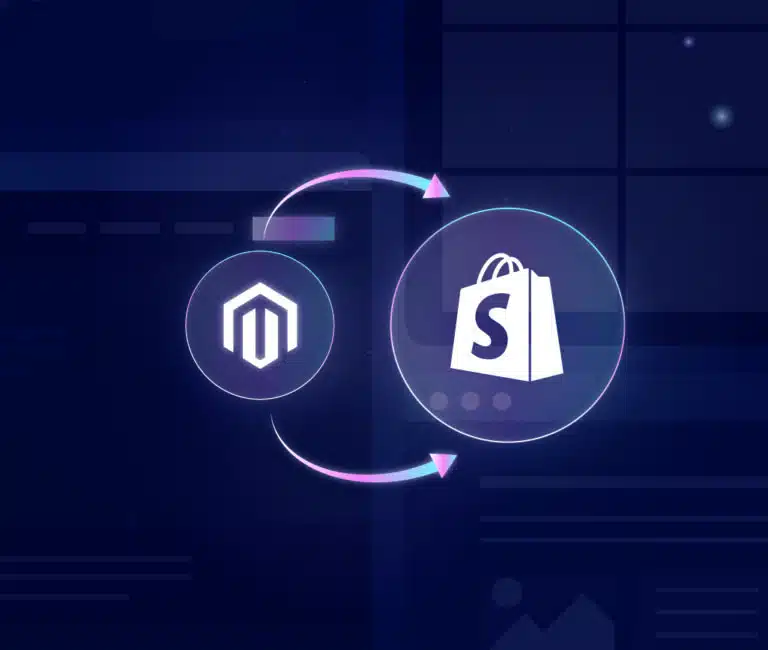Shopify
9 minute read
4 Reasons Why Brands Migrate from Magento to Shopify Plus.
LAST UPDATED:
August 15, 2023


The ecommerce industry continues to grow rapidly. That might not be news to many, but it’s relevant in one crucial way: increasingly, systems that once worked well for a variety of merchants may no longer be the best option for growing audiences, transactions, and engagement.
In this scenario, migration might be the answer. Magento, for example, may power almost 200,000 ecommerce stores across the globe, but that doesn’t mean it’s perfect—far from it.
In many cases, competitors like Shopify (and its premium solution, Shopify Plus) actually become better alternatives in this fast-growing space. This movement is happening for a number of reasons. Before we dig into them, let’s start with a quick exploration of the differences between Magento and Shopify Plus.
Magento grows out of the open-source movement. It’s an ecommerce platform that, at its core, is entirely free and entirely customizable. Merchants can build their online store from scratch, customizing their experience to match their unique niche and audience. That is, if they have the requisite coding and development expertise.
Shopify Plus, in many ways, is the antithesis of Magento’s approach. Though still customizable, it’s a full-service ecommerce solution that’s prebuilt and comes with its own host, along with thousands of apps and extensions that can customize the experience in a more user-friendly way.
One shines through customizability as a true ecommerce sandbox. The other promotes scalability and user-friendliness. Why would brands move on from Magento to complete their Shopify (or Shopify Plus) migration?
A few reasons, actually, and that’s exactly what we’ll answer in this guide.
Initial costs can be deceiving. Its open-source nature means that Magento, at its core, is free. Shopify Plus, on the other hand, starts at $2,000 per month.
And yet, that’s far from the only thing brands and merchants should know. For that price, Shopify Plus offers a huge range of comprehensive services.
That subscription cost, for instance, includes hosting services. It also includes high-tech support, from advanced apps to a launch engineer dedicated to work on the merchant’s behalf. Even charges for external opportunities like POS platforms for physical stores will not require extra fees.
Worried about security? It’s part of the price. So are any efforts related to platform updates or necessary coding and UX adjustments around these updates.
In short, Shopify Plus comes close to being a true all-in-one solution for ecommerce merchants. Crucially, that’s not the case for Magento.
Here, the code is free. Beyond that, costs will begin to rise quickly.
To start, Magento users need to find their own host and pay associated costs. Because of its open-source nature, there will be no support. That, in turn, means paying dedicated developers and programmers each time an adjustment needs to be made.
These costs add up quickly over time. Add to the fact that Magento store sites tend to take longer to build, costs not only rise but also become more difficult to control.
That’s especially the case when merchants look to scale their operations. Increased traffic might require updates or even new hosts to support the added bandwidth. Growing with your audience with a Magento store becomes difficult without additional investments.
In short, Shopify Plus appears expensive at first, but its costs are largely fixed and easy to predict. The more variable costs of operating a Magento-based store tend to be more expensive over time, especially when growing your business.
That’s reason #1 why customers tend to migrate from Magento and moving to Shopify Plus. To see if it’s applicable to your situation, ask yourself whether you’re planning on growing your sales volume, and what you’re currently spending on all store-related web development costs. Adding up these costs, while planning for potential future expansions, can clarify the situation.
Chances are that your business needs more than a bare bones online shop. Your customer acquisition and retention strategies likely require at least some level of customization, cross-selling opportunities, and more.
To solve these more complex business needs, both Magento and Shopify Plus have marketplaces for merchants and brands to leverage. The nature of those marketplaces, though, differs significantly.
If you’re familiar with the WordPress plugin library, Magento’s marketplace may seem familiar. Like its parent platform, all applications and extensions are custom-created by its community. You’ll find nearly 500 extensions in all, ranging from free, community-created solutions to integrations created by major SaaS vendors.
Some of them are great. Others, not so much. The challenge is understanding which fits into what category, and whether your business needs could lead you to an extension that either invites security risks or simply won’t be updated anymore a year or two from now.
Compare that to Shopify’s marketplace of apps. It’s a carefully curated system, with every app vetted by the platform to ensure reliability, quality, and availability.
One area that’s especially beneficial for advanced ecommerce brands is the Shopify Plus Certified App Program. It’s a collection of 49 high-quality applications that, combined, solve most complex problems that advanced and growing merchants may experience. Functionality ranges from automated store backups to personalized recommendations functionality and affiliate marketing opportunities.
Crucially, not all of these apps are free in either case. They’re usually represented by SaaS platforms offering their personalization or affiliate marketing services through Shopify. An informal cross-section of both Magento and Shopify Marketplaces, though, shows that the latter tends to have lower prices, likely due to the lower need for coding from scratch.
How do you know whether this general difference should be a reason for your own Shopify migration? It starts with estimating your current and future business needs.
Any time you foresee complexity in how your online store is built, apps and extensions become a relevant consideration. Beyond that, list your exact needs to improve functionality and success of your online store. That allows you to search for potential solutions in both marketplaces, likely leading to Shopify Plus as the higher-quality build opportunity.
Custom creation can be great—as long as you’re prepared to take advantage of its benefits.
That’s where most ecommerce merchants fall short. Sure, you might strive to be like Amazon, with a team of developers all dedicated to custom-create everything about your store. In that case, you’ll appreciate the freedom Magento provides.
But let’s be honest. Most ecommerce brands don’t have that bandwidth and capabilities. For major tweaks, adjustments, and evolutions of their online store, they need to hire out the development expertise.
Again, this is where Shopify Plus shines.
First, its backend is much more user-friendly than Magento. Menus are more intuitive, and feature or functionality tweaks happen right within the user interface.
Looking to move around elements on your page? Just use simple drag-and-drop mechanisms. Customizing backend features? The intuitive menus will help.
Second, the support provided by the system is nothing to sneeze at. For adjustments and improvements that go beyond simple tweaks, a team of Shopify-provided experts stand by to help.
Compare that with Magento, which has a steep learning curve even for advanced developers. You’ll have plenty of encounters with “naked” code to get to the platform and site you want. And of course, you’ll need to hire out for any external support to help you get there.
The decision point here is pretty straightforward. If you have the in-house web development expertise to build your store from scratch, Magento will not pose major issues.
But if you’re looking for a straightforward solution that allows you to easily manage your store in-house even without that dedicated expertise, migrating to Shopify Plus makes more sense.
In the modern world of ecommerce, security is essential for any merchant. Protecting your business, website, and customer information against online attacks is not really optional.
The cases in the news are typically big corporations like Target and Amazon, but there’s often more to it. Almost half of all cyber attacks target small and medium-sized businesses, while one third of all attacks focus on ecommerce stores.
In other words, website security is a natural priority for any sustainable, growing merchant. So how do Shopify and Magento compare?
We’ll mention it one more time: Magento, as an open-source solution, largely allows brands to fend for themselves. The website owner is responsible for monitoring any potential security patches or extensions, and implementing website updates.
Stay up-to-date with a top-notch developer, and you should be safe, but it’s difficult to do so. That’s why attacks like the 2018 card-skimming hack on a Magento site, which affected more than 7,000 websites, can be so devastating.
With Shopify Plus, security is more tightly integrated into the system.
Protip
All Shopify-based sites and stores have SSL certificate, and the platform’s security level covers all six PCI standard categories.
All Shopify-based sites and stores have SSL certificate, and the platform’s security level covers all six PCI standard categories. In plain English, that means your store (and its host) will remain safe, and keep your customer information secure, at the highest possible levels.
In short, the decision point here is simple. Security is a core ecommerce priority, and Shopify offers stronger security levels than Magento. It’s a core reason for migration, regardless of your individual situation.
Combine the above four points, and the reasons for migrating from Magento to Shopify Plus become clear. It’s important to note, however, that some benefits of Magento do remain when compared to its competitor.
First, we’ve hinted throughout this post at the customization capabilities of Magento. Because it’s open source, everything is available for tweaks and changes. An experienced development team can leverage this customizability to build truly unique online shopping experiences.
One example of greater flexibility is the checkout customization potential of Magento. Though it can be somewhat modified, Shopify’s checkout system is relatively streamlined. In Magento, on the other hand, merchants can create custom, branded experiences that carry the look and feel from the website and store through the entire buyer’s journey.
The open source nature of Magento also comes with its own advantages. The large development community tends to crowdsource solutions, naturally evolving and improving the platform over time. Magento from a few years ago looks nothing like the Magento of today. The centrally-delivered Shopify iterates more like you would expect from a website vendor.
Finally, its global spread has made Magento a great option for multinational ecommerce brands. More flexible payment options and a larger international community are a few of the features that have made it a favorite for international merchants.
Magento is not perfect, but it’s popular for a reason. Carefully weighing its benefits and drawbacks is essential if you want to make the right decision when considering a Shopify migration.
The flexibility and customization options of Magento are undeniable. At the same time, it’s crucial to think through the considerable cost and effort required to bring a Magento website online.
And even once it is online, adjustments, updates, and evolutions of your online store will become necessary. Each requires a major lift with significant design and development expertise, which few ecommerce merchants and brands have.
By contrast, Shopify Plus does much of the work for you. Its plug-and-play nature is perfect for the evolving and growing ecommerce market. Integrated features make it easier to manage, without losing the advanced features you need to build your ecommerce website.
Before you migrate from Magento, familiarize yourself with some caveats we’ve mentioned above. Generally speaking though, Shopify Plus tends to be the best choice for merchants looking to build towards their future.
Over to you. Is your website and online store running on Magento or Shopify? What benefits or drawbacks have you seen on Magento, and how might a move to Shopify help? Share your thoughts in the comments below.
Get Memorable Insights.
Sign up to receive actionable web design advice directly in your inbox monthly.
Get Memorable Insights.
Sign up to receive actionable web design advice directly in your inbox monthly.
Author
Jeff Gapinski is the President of Huemor where he helps plan the long-term strategic growth of the agency. Jeff is passionate about UI/UX, demand generation, and digital strategy.
What Do You Think?
Have feedback? Maybe some questions? Whatever it is, we'd love to hear from you.




![Website Design Standards We Follow [That You Should Too!]](https://huemordev.b-cdn.net/wp-content/uploads/2021/12/2023.04.04.Website-Design-Standards-We-Follow-That-You-Should-Too.jpg.webp)



No comments found